Terracotta planters with herbs are like the cozy socks of gardening—rustic, charming, and they make your space smell like a fresh spring day. These pots give your basil or rosemary the perfect home to thrive, all while adding that earthy glow to your porch or kitchen. I dove into this last spring, and yeah, I drowned my cilantro by accident, but my patio’s now a green little paradise. This guide’s packed with down-to-earth tips and tricks to grow your own herb jungle in terracotta, even if your green thumb’s as shaky as mine.
Why Terracotta Planters with Herbs Create Natural Magic
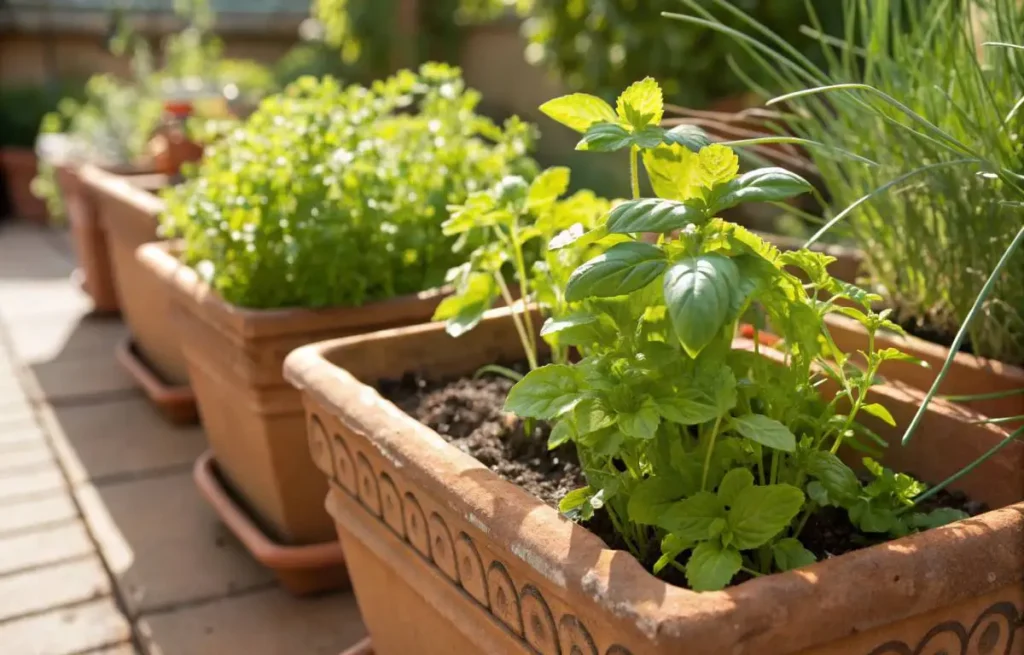
The Charm of Terracotta Planters with Herbs in Spring
Terracotta planters bursting with herbs are like spring’s warm hug for your home. Their earthy, porous clay has this rustic vibe that plastic pots can’t touch, blending sight, smell, and texture into something special. I set up a few on my porch last spring, and despite my sloppy potting, the basil’s scent was pure joy. That burnt-orange hue feels like it’s straight from the ground, making your herbs look like they’re thriving right out of the earth. It’s got this old-school charm—used for centuries everywhere—and seeing green herbs pop against it just screams renewal, perfect for spring’s fresh start.
Benefits of Growing Herbs in Terracotta Planters
Terracotta’s not just pretty; it’s a game-changer for herbs. The clay’s breathable, letting air and water sneak through to keep roots happy and avoid rot—unlike plastic, which traps water like a clingy ex. Herbs like thyme or rosemary love that well-drained vibe, and my oregano’s never been lusher. Plus, terracotta keeps soil cool in heat and cozy in cold, so your herbs stay comfy even in spring’s wonky weather. The rough texture gives roots a grip, too, so my mint didn’t topple in a gusty storm, though I still spilled soil everywhere.
How Terracotta Planters with Herbs Improve Wellness
Growing herbs in terracotta isn’t just gardening—it’s a mood-lifter. Tending plants chills you out, and studies back it up; I read somewhere that rosemary’s scent can even sharpen your brain—mine smells like focus, even if I forget to water it. Popping basil or mint in your kitchen adds a zesty vibe, and in spring, it’s like a mini rebirth ritual. I started a routine of watering my herbs, and it’s weirdly grounding, even if I got mud on my shoes. Those little pots bring nature’s calm into your day, making your space and soul feel a bit brighter.
Best Herbs to Plant in Terracotta Planters for Spring
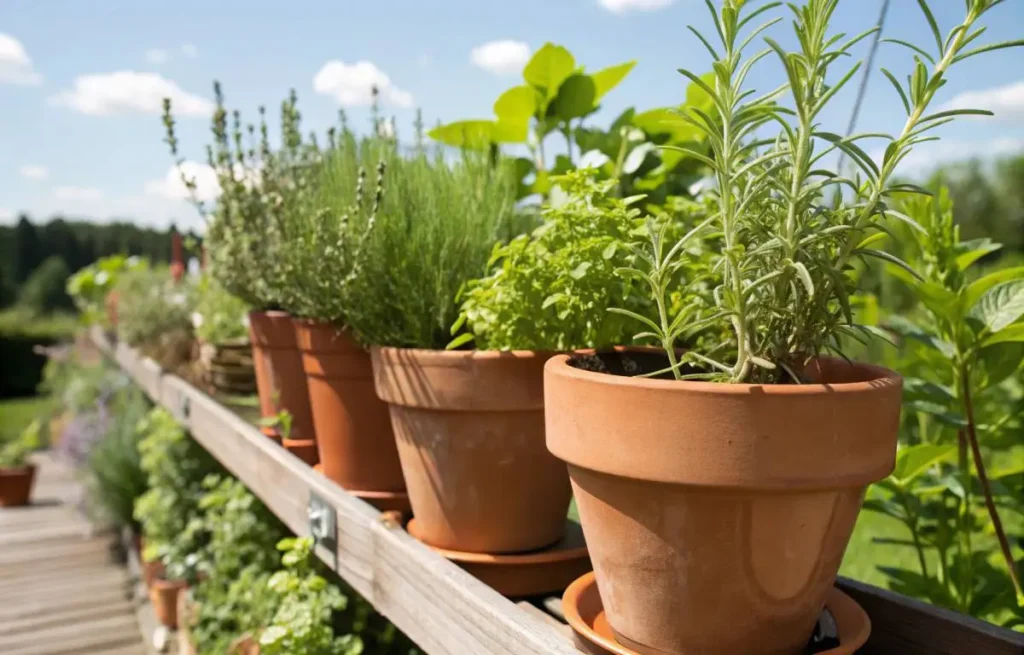
Low-Maintenance Herbs That Thrive in Terracotta Planters
Spring’s the perfect time to grow easy herbs that don’t need babysitting, and terracotta planters are their best friend. Mint, oregano, and parsley are my go-tos—they’re tough and happy in clay pots. Mint grows like a weed; I stuck some in a terracotta pot to keep it from taking over my yard, and it’s thriving despite my spotty watering. Oregano and parsley love the well-drained soil terracotta provides, needing just a splash of water now and then. These forgiving herbs are great for newbies like me, who once forgot a pot outside all week, and they still keep your garden dreams alive.
Fragrant Herbs Perfect for Terracotta Planters with Herbs
For a spring garden that smells like heaven, go for rosemary, thyme, or lavender in terracotta pots—their scents just pop in that breathable clay. Rosemary’s my fave; it stays happy with terracotta’s moisture control, since I tend to overwater everything. Its aroma fills my patio, even if I knock leaves everywhere. Thyme, the so-called “queen of herbs,” grows all cute and compact, releasing tiny scent bursts when I brush by. Lavender’s floral vibe draws bees and looks dreamy; my pots are a bit mismatched, but they make my garden feel like a springtime fairy tale.
Edible Herbs for Terracotta Planters in Your Kitchen Garden
If you love cooking with fresh stuff, terracotta planters with basil or chives are a game-changer for your kitchen. Basil adores the sunny spring vibes and terracotta’s well-drained soil—I learned the hard way not to drown it, and now it’s my pasta’s best friend. Chives bring a subtle oniony kick and grow like champs with minimal fuss, perfect for my tiny windowsill. Having these herbs right there while I’m cooking feels like wizardry, even if I spill dirt on the counter every time I snip some. Terracotta makes it easy and adds that satisfying, homegrown magic to every dish.
How to Prepare Terracotta Planters for Lasting Growth
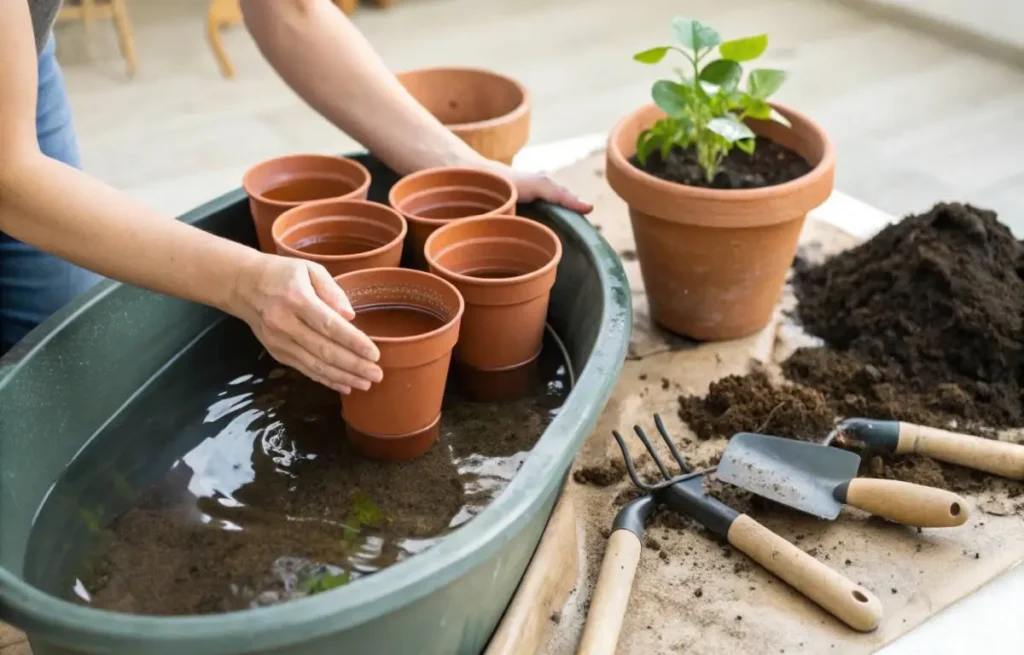
Soaking and Sealing Terracotta Planters Before Use
Don’t skip soaking your terracotta pots—it’s a game-changer for keeping herbs happy. Unsoaked clay sucks water from the soil like a sponge, leaving your plants thirsty. I forgot this once, and my thyme was not impressed. Soak the pots for a few hours or overnight to let the clay drink up evenly; it helps balance moisture. Sealing the inside with a natural sealant can make pots last longer and slow drying, especially in dry climates. I tried sealing one, but overdid it and lost some breathability—go easy to keep that terracotta magic, even if your sink’s a muddy mess like mine.
The Right Potting Mix for Terracotta Planters with Herbs
Terracotta’s porous vibe needs a potting mix that’s just right—not too wet, not too dry. Go for a blend with peat moss or coconut coir to hold moisture, mixed with perlite or coarse sand for drainage. I tossed in some compost for my basil, and it’s growing like a champ, though I spilled half the bag on my porch. Homemade mixes tailored to your herbs beat generic store soil hands-down. It’s part science, part guesswork—too heavy, and roots choke; too light, and water’s gone in a flash. Terracotta’s forgiving, but getting this mix right is key.
Adding Drainage and Preventing Root Rot in Herb Planters
Drainage is everything with terracotta herb planters—nobody wants soggy roots. Most pots have holes, but I add a layer of gravel or broken pottery shards at the bottom to keep water moving; I used a smashed mug once, and it worked like a charm. Root rot’s a herb killer, often from overwatering, but terracotta’s breathability helps. Still, you gotta stay sharp—spring’s weird weather had me overwatering my parsley out of paranoia. Check the soil before watering instead of sticking to a schedule; it’s saved my herbs, even if my hands are perpetually dirt-stained.
Decorating with Terracotta Planters and Herbs Indoors & Out
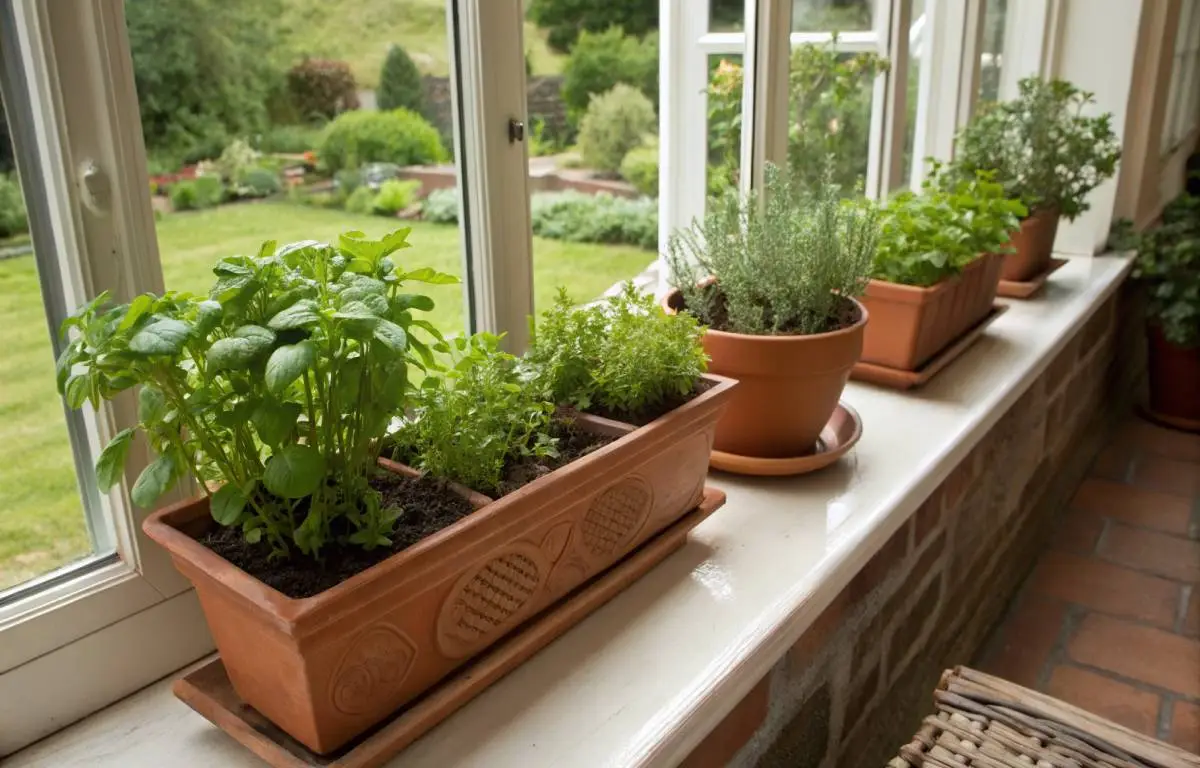
Displaying Terracotta Planters with Herbs on Patios and Porches
Terracotta planters are like the perfect patio sidekick, blending with wood or stone for that natural, springtime vibe. Cluster pots in different sizes for a cozy, artsy look—I threw some together on my porch, and it’s a hot mess of charm, even if I knocked one over. Mix tall rosemary with trailing thyme for some height drama, and pop them on crates or shelves for better sun and easy picking. These herb gardens turn your patio into a living, touchable decor piece that’s way more fun than a boring statue, inviting everyone to sniff or snag a sprig.
Using Terracotta Planters with Herbs as Kitchen Decor
Terracotta herb planters in the kitchen are a total win, bringing warmth and fresh flavors right where you cook. Stick a few on your windowsill or shelves for a pop of green and that herby aroma—my basil pot’s my kitchen’s MVP, though I’ve spilled soil on the counter more than once. The clay’s rustic look fits everything from farmhouse to sleek modern vibes, and having herbs nearby makes you chop them fresh, which feels like chef magic. The more you snip, the more they grow, keeping your kitchen lively and your dishes tasty.
Creating Vertical Gardens with Terracotta Herb Planters
Got a tiny space? Go vertical with terracotta pots for a genius herb garden. Wall-mounted planters or tiered shelves let you pack in herbs without cluttering—I tried this on my balcony, and it’s a green jungle now, even if I fumbled the setup. It’s great for sunlight and airflow, which terracotta herbs love, and it turns a small nook into a lush oasis. Vertical gardens take a bit of planning, but the payoff’s huge: fresh herbs at arm’s reach and a dreamy look that’s pure springtime magic, despite my slightly crooked shelves.
Care Tips to Keep Terracotta Planters with Herbs Thriving
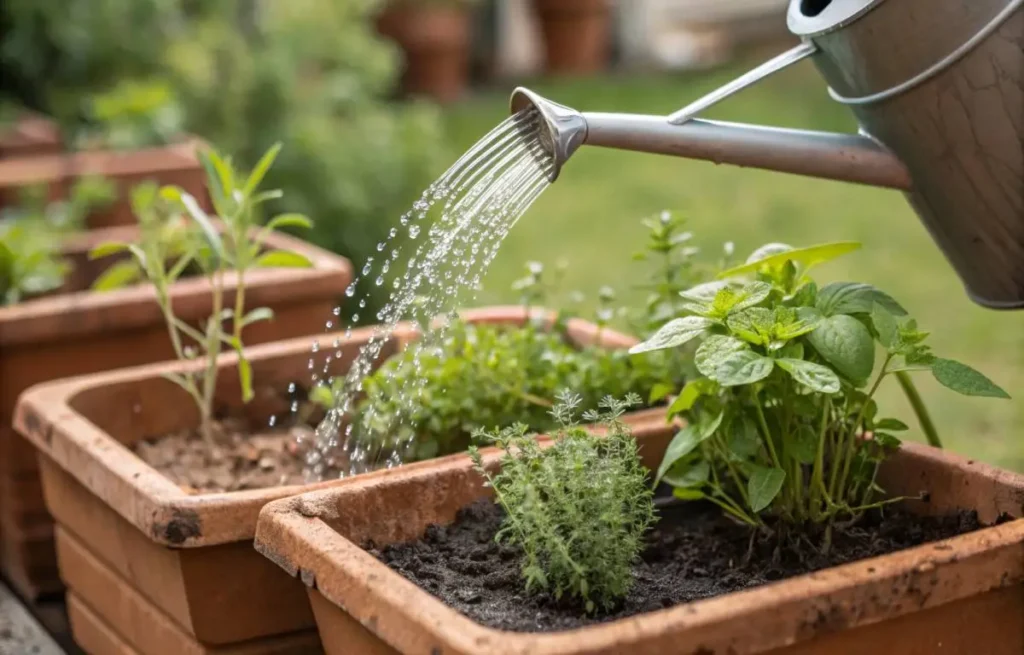
Watering Schedule for Terracotta Planters with Herbs
Terracotta pots are thirsty little things, drying out faster than plastic, so you’ve gotta keep an eye on them, especially in spring’s warm days. I check my soil every day, watering when the top inch feels dry—learned that after nearly drowning my rosemary in a panic. Don’t overdo it; droopy herbs don’t always need a flood, and soggy roots are bad news. Tweak your watering based on the weather, herb type, and pot size—mint’s cool with extra moisture, but my rosemary likes it dry. It’s a bit of a guessing game, but my herbs are happy, even if my porch is a splash zone.
Fertilizing Herbs in Porous Terracotta Planters Naturally
Natural fertilizers are the way to go for happy herbs without overloading them. I use diluted seaweed or compost tea every few weeks, and my basil’s leaves are practically glowing, though I spilled some on my shoes once. Since terracotta’s so breathable, nutrients slip out fast, so you need to feed regularly but gently—skip heavy chemical stuff that can fry delicate roots. It’s all about keeping those herbs lush and fragrant, making your kitchen smell like a springtime dream, even if your mixing bowl’s a bit funky now.
Preventing Mold and Staining on Terracotta Herb Pots
Terracotta’s porous vibe can pick up water stains or salt marks, which I kinda love for that rustic look, but mold’s a no-go. Scrub pots every few months with a soft brush and a mild vinegar mix to keep them fresh—I tried this, but got vinegar on my shirt, oops. Good airflow and sunlight help stop algae from crashing the party. Some folks dig the weathered patina that builds up; it’s like your pots are telling a story. My oregano pot’s got this cool, lived-in charm now, even if it’s not Instagram-perfect.
Conclusion
Terracotta planters with herbs are like a springtime love song for your home, blending rustic beauty with practical perks and a whiff of fresh scents. Their breathable clay makes herbs like rosemary, basil, or mint thrive, keeping moisture and temps just right—I started mine last spring, and despite some dirt on my floor, my kitchen’s a green paradise now. Get the prep right—soaking pots, picking good soil, watering smart, and feeding gently—and your herbs will flourish. Whether they’re chilling on your patio, crowding your windowsill, or stacked in a vertical garden, these pots turn any spot into a fragrant oasis. It’s not just gardening; it’s building a tiny, magical world that feeds your soul and your recipes, even if your hands end up as earthy as mine.
People Also Read
Painting Terracotta Pots: A Complete Guide to Tips and Techniques
Mexican Kitchen Decor: Made Our First Home Feel Like Forever
FAQs
What herbs grow best in terracotta planters?
Herbs like rosemary, basil, thyme, and mint thrive well in terracotta planters due to good drainage and breathability.
How often should I water herbs in terracotta planters?
Water when the top inch of soil feels dry; terracotta absorbs moisture quickly, so herbs may need watering more often than in plastic pots.
Do terracotta planters need special preparation before planting herbs?
Yes, soaking terracotta pots in water before planting helps prevent them from drawing moisture away from the soil.
Can terracotta planters be used indoors for herbs?
Absolutely, they add natural charm and work well indoors if placed where herbs get enough sunlight.
How do I prevent terracotta planters from cracking?
Avoid sudden temperature changes and keep them moist before freezing weather; soaking before use also helps reduce cracking.
